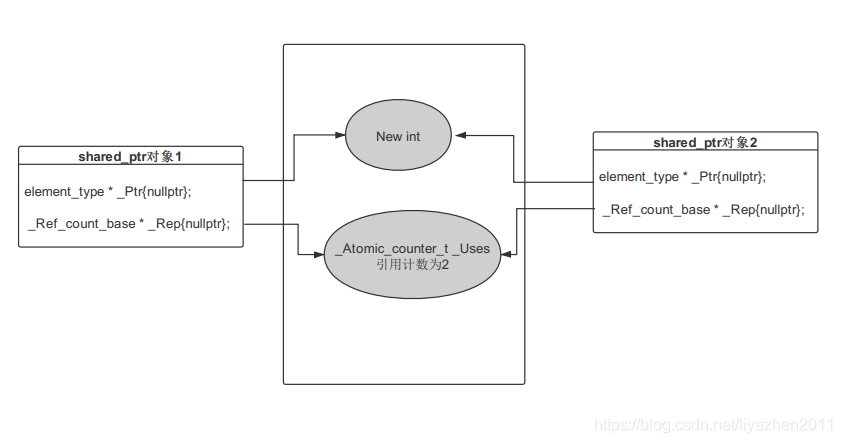本文先分析shared_ptr的内部实现原理,然后实例演示shared_ptr的使用。
1. 实现原理
shared_ptr的定义如下:
template<class _Ty>
class shared_ptr : public _Ptr_base<_Ty>shared_ptr从基类_Ptr_base 继承了如下成员变量(部分源码):
template<class _Ty>
class _Ptr_base
{
private:
element_type * _Ptr{ nullptr }; //指向资源
_Ref_count_base * _Rep{ nullptr }; //指向资源引用计数
}其中,_Ptr指向资源,_Rep指向资源引用计数。
_Ref_count_base的定义如下:
class __declspec(novtable) _Ref_count_base
{ // common code for reference counting
private:
_Atomic_counter_t _Uses; //记录了引用资源的shared_ptr的个数
_Atomic_counter_t _Weaks; //记录了weak_ptr的个数
}其中,Uses记录了资源的引用计数,也就是引用资源的shared_ptr 的个数;_Weaks记录了weak_ptr的个数,相当于资源观察者的个数。
shared_ptr的构造函数定义如下:
template<class _Ux,
enable_if_t<conjunction_v<conditional_t<is_array_v<_Ty>, _Can_array_delete<_Ux>, _Can_scalar_delete<_Ux>>,
_SP_convertible<_Ux, _Ty>>, int> = 0>
explicit shared_ptr(_Ux * _Px)
{ // construct shared_ptr object that owns _Px
_Setp(_Px, is_array<_Ty>{});
}
template<class _Ux>
void _Setp(_Ux * _Px, false_type)
{ // take ownership of _Px
_TRY_BEGIN // allocate control block and set
_Set_ptr_rep_and_enable_shared(_Px, new _Ref_count<_Ux>(_Px));
_CATCH_ALL // allocation failed, delete resource
delete _Px;
_RERAISE;
_CATCH_END
}shared_ptr的构造函数中会开辟新的引用计数的资源。
shared_ptr的拷贝构造函数定义如下:
shared_ptr(const shared_ptr& _Other) noexcept
{ // construct shared_ptr object that owns same resource as _Other
this->_Copy_construct_from(_Other);
}
template<class _Ty2>
void _Copy_construct_from(const shared_ptr<_Ty2>& _Other)
{ // implement shared_ptr's (converting) copy ctor
if (_Other._Rep)
{
_Other._Rep->_Incref();
}
_Ptr = _Other._Ptr;
_Rep = _Other._Rep;
}
shared_ptr的拷贝构造函数没有开辟新的引用计数的资源,只是引用计数加1。
2.代码实例
先看下面出错的例子:
#include <iostream>
#include <memory>
using namespace std;
int main()
{
// 裸指针指向堆上的对象
int *p = new int;
shared_ptr<int> ptr1(p);
shared_ptr<int> ptr2(p);
//两次打印都是1,析构两次,出错
cout << "use_count = " << ptr1.use_count() << endl;
cout << "use_count = " << ptr2.use_count() << endl;
getchar();
return 0;
}执行结果:

原因:ptr1(p) 和 ptr2(p)都调用了shared_ptr的构造函数,它们管理同一个资源,但是重新开辟了引用计数的资源。所以引用计数都为1。析构函数会被调用两次,所以程序出错。

正确的代码如下:
#include <iostream>
#include <memory>
using namespace std;
int main()
{
// 裸指针指向堆上的对象
int *p = new int;
shared_ptr<int> ptr1(p);
shared_ptr<int> ptr2(ptr1);
//两次打印都是2,析构一次,正确
cout << "use_count = " << ptr1.use_count() << endl;
cout << "use_count = " << ptr2.use_count() << endl;
getchar();
return 0;
}执行结果:

原因:ptr1(p) 调用构造函数,ptr2(ptr1)调用拷贝构造函数(没有开辟新的引用计数的资源,只是引用计数加1)。析构函数会被调用一次,所以程序正确。

